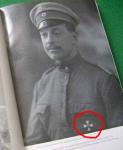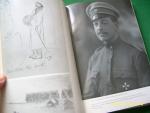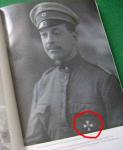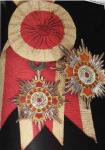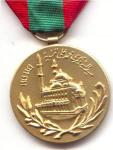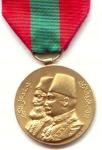
lilo
Active Contributor-
Posts
474 -
Joined
-
Last visited
Content Type
Profiles
Forums
Blogs
Gallery
Events
Store
Everything posted by lilo
-
Hello Rick After all day passed in searching for this 'white enamelled cross' I was starting to suspect that it wasn't at all an Order but some sort of Russian (or less probable Polish) unit badge. I didn't told this before because I didn't want influence nobody with my thinking to have a more free guess. However I would hear also what others think about Rick's and mine guessing. Kevin, Unfortunately I don't have the book in question (I took the photo from ebay) so that I posted is all that I can post. Awaiting to hear more from you Regards Lilo
-
Hello All, I'm new of this forum and I would like to know if some of you can help me in correctly identify an Order weared by the future british Field Marshal Harold Rupert Leofric George ALEXANDER, when He was the commander of THE LANDWEHR in Latvia in 1919. Below I have attached a photo (taken from a biographical book of Field Marshal H.R.L.G. ALEXANDER) that show the young Alexander wearing an uniform that seems to be Russian or German [??]. Below this photo there is an inscription that is almost illegible but that make as following : 'COMMANDER OF THE LANDWEHR in Latvia 1919' As you can easily note, in the same photo Alexander clearly wear a 'White Enamelled Cross' on his left breast. Moreover, a kind member of another forum gave me the following information taken from the 'Oxford Dictionary of National Biography':- Quote: "Not wishing to go back to barracks or to the army of occupation in Germany, Alexander applied in 1919 for an appointment to one of the many military missions in eastern Europe. He was first posted as a member of the allied relief commission in Poland under Stephen Tallents and later went with Tallents to Latvia, which was in danger of falling either to Russia or to Germany. The allies had no troops in the Baltic and only a small naval detachment under Sir Walter Cowan. Tallents placed the Landwehr, composed of Baltic Germans, under Alexander's command. At the age of twenty-seven he found himself at the head of a brigade-sized formation with mainly German officers. He was good at languages and had taught himself German and Russian; his authority derived from his charm and sincerity and his obvious professionalism. He kept his men steady and resistant to the attractions of the German expeditionary force under von der Goltz and led them to victory in the campaign which drove the Red Army from Latvia.. Alexander retained all his life a keen interest in Russia. During the First World War he designed a new uniform cap for himself with a high visor and flat peak, on the model of one he had seen a Russian officer wearing. He always wore the order of St Anne with swords which Yudenich awarded him in 1919; when he met Rokossovsky in 1945 the Russian general muttered to him in an aside that he had once had it too. In the Second World War, like Churchill, he admired Stalin and was enthusiastic about the Soviet army." Unquote : Having NOT clear the exact nationality of the 'Landwehr' and, in consequence, of the relative uniform weared by Alexander in the photo, I tried to compare some photo of 'Russian' and 'German' Orders I have in my database but any match with the Cross in the photo. Someone also suggested me to check any of the White Russian Orders but what I found still didn't match. My Question : Any idea about what is the Order He is wearing in the photo ? Awaiting to hear from you Best Regards Lilo P.S. for obvious reasons I repost this thread in the 'Imperial Germany' section of this splendid forum.
-
Hello All, I'm new of this forum and I would like to know if some of you can help me in correctly identify an Order weared by the future british Field Marshal Harold Rupert Leofric George ALEXANDER, when He was the commander of THE LANDWEHR in Latvia in 1919. Below I have attached a photo (taken from a biographical book of Field Marshal H.R.L.G. ALEXANDER) that show the young Alexander wearing an uniform that seems to be Russian or German [??]. Below this photo there is an inscription that is almost illegible but that make as following : 'COMMANDER OF THE LANDWEHR in Latvia 1919' As you can easily note, in the same photo Alexander clearly wear a 'White Enamelled Cross' on his left breast. Moreover, a kind member of another forum gave me the following information taken from the 'Oxford Dictionary of National Biography':- Quote: "Not wishing to go back to barracks or to the army of occupation in Germany, Alexander applied in 1919 for an appointment to one of the many military missions in eastern Europe. He was first posted as a member of the allied relief commission in Poland under Stephen Tallents and later went with Tallents to Latvia, which was in danger of falling either to Russia or to Germany. The allies had no troops in the Baltic and only a small naval detachment under Sir Walter Cowan. Tallents placed the Landwehr, composed of Baltic Germans, under Alexander's command. At the age of twenty-seven he found himself at the head of a brigade-sized formation with mainly German officers. He was good at languages and had taught himself German and Russian; his authority derived from his charm and sincerity and his obvious professionalism. He kept his men steady and resistant to the attractions of the German expeditionary force under von der Goltz and led them to victory in the campaign which drove the Red Army from Latvia.. Alexander retained all his life a keen interest in Russia. During the First World War he designed a new uniform cap for himself with a high visor and flat peak, on the model of one he had seen a Russian officer wearing. He always wore the order of St Anne with swords which Yudenich awarded him in 1919; when he met Rokossovsky in 1945 the Russian general muttered to him in an aside that he had once had it too. In the Second World War, like Churchill, he admired Stalin and was enthusiastic about the Soviet army." Unquote : Having NOT clear the exact nationality of the 'Landwehr' and, in consequence, of the relative uniform weared by Alexander in the photo, I tried to compare some photo of 'Russian' and 'German' Orders I have in my database but any match with the Cross in the photo. Someone also suggested me to check any of the White Russian Orders but what I found still didn't match. My Question : Any idea about what is the Order He is wearing in the photo ? Awaiting to hear from you Best Regards Lilo P.S. for obvious reasons I repost this thread in the 'Imperial Russia' section of this splendid forum.
-
Hello All I?m searching the full medal entitlement of british Field Marshal Herbert Charles Onslow PLUMER (1857-1932) and would like to know if he was awarded the French Legion d?Honor. I know that Plumer received the ?France, WW1 Croix de Guerre (gazetted in March 1919 and Dec. 1917) so it seems a little odd that He didn?t received the France Legion d?Honor. Unfortunately I was not able to find on L.G. a confirmation as Him to be awarded also the French Legion d?Honor. - Can anyone let me have this confirmation telling when was awarded and which class ? Any help would be much appreciated Best Regards Lilo
-
Hello Hugh, You told me that the ribbon colours of the 1st and 2nd classes of the ?Precious and Brilliant Golden Grain? and Golden Grain? Orders are as following : The sash(ribbon) of the Order of the Precious and Brilliant Golden Grain: 1st Class: red with yellow border; 2nd Class: red with blue border. The sash(ribbon) of the Order of the Golden Grain: 1st Class: yellow with red border; 2nd Class: yellow with white border. I would have some clarification as following : 1) A propos of the colours of the ribbon of the Order of the 'Precious and Brilliant Golden Grain', in the auction catalog of Sotheby?s (24-28/3/1995) I have found 2 Lots with two distinct photos -one in colour for the 1st class and the other in B/W for the 2nd class - of the Chinese, Order of the Precious Golden Grain. Following are the extract of the descriptions in the catalog : -Lot 341 (color photo on pag 71): China, Order of the Precious Golden Grain [or Excellent Crop], by the Chinese Government Mint, Great War Period, 1st class (with Gran Cordon and Jewels) set of insigna, comprising sash badge and breast star ??????etc???????with original red and yellow sash. -Lot 342 (B/N photo on pag 74) : China, Order of the Precious Golden Grain [or Excellent Crop], by the Chinese Government Mint, Great War Period, Sash class, 2nd class set of insigna, comprising sash badge and breast star. I have below attached the 2 photos (1st and 2nd classes) from which you can see/note the colours for both the 1st and the 2nd classes ribbons. Moreover, as you can note in both the descriptions were used the words : 'Great War Period' meaning that these examples were issued for WW1. Regarding in particular the 2nd class, the colours of the (sash) ribbon, although the photo is in B/W, can be clearly desumed confronting the various grey shades of the B/W photo with the colour photo of the 1st class : they appears to be inverted. So the conclusion to which I arrived is that the colours for the 2nd class are : ?yellow central stripe + 2 edge red stripes?. This clearly differ with the description you made of the colours (red with blue border) of the 2nd class of this Order. My questions : Can it be that during WW1 for the 2nd class of this Order were used the colours : 'yellow central stripe + 2 red edge stripes' ? Or these colours were used when the 2nd class of this Order was issued to a foreign (as can be an UK national) ? What do you know/think about it ? 2) The following considerations are ESCLUSIVELY referred to the 1st and 2nd classes of the Golden Grain (not also to the other numerous classes of this Order). A fellow collector (of whom I don't remember the name) explained me that 2 different types of ribbons were used for the ribbon colours of the 'Golden Grain' order,. This collector told me : "The original issue colours of the Golden Grain ribbon was yellow with red borders (1st type ribbon). This was changed in 1916 to yellow with white border (2nd type ribbon). I ALSO was suggested that the ?yellow with white border? was contemporaneously used for both the 1st and the 2nd classes, and athough the most part of the photographic references I found seems to confirm this I discovered some evidence that confirmed that really 2 ribbons with different colours were used for the Golden Grain Order. To confirm the use of these 2 different colours of ribbons, I have attached 2 photos (3 and 4) as following : The first photo I have attached is from (I think) a Chinese museum and the Golden Grain shown is a 1st class suspended from a Yellow (that is so faded to seem white) wide central stripe and 2 red edge stripes sash (see photo nr. 3 attached). The second photo is taken also from the Sotheby?s catalog (24-28/3/1995) to which I referred to above: -Lot 343 (B/W photo on pag 75): China, Order of the Golden Grain, by the Chinese Government Mint, Great War Period, GRAND CROSS [= 1st class] set of insigna, comprising sash badge and breast star ????????etc???????with original yellow and red sash(see photo nr. 4 attached). As you can note both photos (and the description) I attached, refer to a 1st class and both have the same colours (yellow with red border). This perfectly coincide with the colours of the ribbon you told the 1st class of the Golden Grain Order has. My question is simple : Does the difference in the use of the colours of the ribbons is strictly linked to a change of ?class? (i.e. different class = different colours) or does it depends from a ?temporal factor? i.e. from a certain period on (possibily from 1916 on ???) there was a change in the colours of the ribbons ? In other words ?after having established that 2 different colours for the Golden Grain Ribbon were used- the change in the use of these colours depends from the particular ?class? (i.e. 1st or 2nd) or the change regards a particular ?data? (possibily from 1916 on ???) and ?obviously -in this case the colours were identical for both the 1st and the 2nd classes ? awaiting to hear from you Best Regards Lilo P:S: as the photos are too large to being attached to this posting, I please you to see them as attached to another forum following the link : <a href="http://www.omsa.org/forums/showthread.php?p=9603&posted=1#post9603" target="_blank">http://www.omsa.org/forums/showthread.php?...sted=1#post9603</a> . The photo are put on my post nr. #7
-
Hello Richard, Thanks for your very precious informations that helped me in further understanding these 2 Orders. I need ? if possible ? that you specifically answer each of the below questions: 1) Does the Order of Chia-Ho followed by the words "Ta-Shou Pao-Kuang" exactly identify the Order of the 'Precious and Brilliant Golden Grain' ? 2) Am I correct that the words 'Excellent Crop' were exclusively used to indentify the Order of the 'Precious and Brilliant Golden Grain' and NOT also the Order of the 'Golden Grain' ? 3) Regarding the ribbon of the 'Golden Grain' order, can you confirm or not that is true what told me a friend collector that were used 2 types of ribbons ("The original issue colours of the Golden Grain ribbon was yellow with red borders. This was changed in 1916 to yellow with white border") ? 4) A propos of the colours of the ribbon of the Order of the 'Precious and Brilliant Golden Grain' can you confirm that the : -1st class is ?red with yellow border? ? -2nd class has the above colours inverted and so is ?yellow with red border? ? If you will have the patience to answer the 4 questions (you can simply answer also with a ?yes? or ?not?) then I will have all clear about these two orders and will have the possibility to take to a end the search project I?m doing Awaiting to hear from you again Best Regards Lilo
-
Hello Hugh, thank you All the best Lilo
-
Hello Adam, First of all I would like to thank you for your prompt and very informative answer. I apologise in advance but need of some more specific answers as following : 1) I know that the Order of the 'Precious and Brilliant Golden Grain' and the Order of the 'Golden Grain' -although have similar names - are completely different Orders : Is this correct ? If yes and if I well understood what you have written above and confronting it to what is written in the London Gazette, Field Marshal Douglas Haig received exactly the Order of the 'Precious and Brilliant Golden Grain' and, instead, General Sir William Robert Robertson received exactly the Order of the 'Golden Grain' : Am I correct ?? 2) Am I correct that the words 'Excellent Crop' were exclusively used to indentify the Order of the 'Precious and Brilliant Golden Grain' and NOT also the Order of the 'Golden Grain' ? 3) Moreover a friend collector (of which I don't remember the name) told me that were used 2 types of ribbons for the 'Golden Grain' order : "The original issue colours of the Golden Grain ribbon, 100mm wide, was yellow with red borders (1st type). This was changed in 1916 to yellow with 16mm white border (2nd type)". Is this correct ? 4) Last, I have always understood that either the 1st type of ribbon or the 2nd type (each for the correct period of issue) were adopted contemporaneously for both the 1st and 2nd classes. In other words I mean that, taking as example the 2nd type ribbon (that yellow with 16mm white border), it was used for both the 1st and 2nd class. Am I correct ?? I greatly appreciate if you can help me further and Hope that you can do so (If not my search will go to a dead end). Awaiting to hear from you again Best Regards Lilo
-
Hello All, I would like to ask your help to exactly identify the Chinese Orders Given to some High ranking British Generals for the WW1. In particular on the London Gazette of 17 FEBRUARY, 1920, I found the following entries : the KING has given unrestricted permission to wear the Decorations and medals conferred by his excellency the president of the Republic of China: Order of Chia-Ho. 1st Class. "Ta-Shou Pao-Kuang" To Field-Marshal Douglas, Earl Haig Order of Chia-Ho. 2nd Class. "Ta-Shou" to General Sir John Steven Cowans Order of Chia-Ho. 1st Class. To General Sir William Robert Robertson, My question are : 1) What means the word "Chia-Ho" ? 2) What means the word "Ta-Shou Pao-Kuang" ? 3) What means the word "Ta-Shou" ? 4) It appears that the Order in question is an unic Order named ?Chia-Ho?. What then is the difference between the Chia-Ho Order followed by the words "Ta-Shou Pao-Kuang" or "Ta-Shou" or with nothing as in the case of General Robertson ? Awaiting to hear from you Best Regards Lilo
-
Hi Owain, Thanks very much for the replay. Regards Lilo P.S. do you have a photo of Nasser with His medals or one representing the MOD awarded to Nasser ?
-
Hello Owain, Thank you for your very interesting posting. I don't know if the award of his Mohamed Al? medal was related to his VC action but His link with Egypt / Sudan is clear from the short bio that I took from the King's College London Liddell Hart Centre for Military Archives; see http://www.kcl.ac.uk/lhcma/locreg/ROBERTS2.shtml ROBERTS, Frank Crowther (1891-1982), Major General : Joined Worcestershire Regt 1911; World War I in France and Belgium 1914-1918; Staff Capt, France 1916; Bde Maj, France 1916-1917; Officer Commanding 1 Bn, Worcestershire Regt 1917-1918; attached to Egyptian Army, Sudan 1919-1920; Staff College, Camberley 1921; General Staff Officer Grade 3, Egypt 1923-1924; Bde Maj, Rhine Army 1925-1926; General Staff Officer Grade 2, South China 1926-1928; transferred to Royal Warwickshire Regt 1927; Inspector, General Staff Branch, Iraq Army 1931-1932; Inspector, British Military Mission, Iraq Army 1932-1934; General Staff Officer Grade 2, Northern Ireland District 1935-1936; Col commanding 1 Bn, Royal Warwickshire Regt 1936; Local Brigadier, Southern Command, India 1937; Commander, Poona Independent Bde 1938-1939; Commander, 48 (South Midland) Div, Territorial Army 1939; retired 1939. As information I remenber to have seen a silver medal of the Order in question, on sale on ebay some year ago. Before to close my posting I would like to ask you, Owain, two things : 1) Do you confirm that is the medal with the 'green/white ribbon' (that that I identified in my preceding post with the name 'Silver Medal') the exact medal associated with the Order of Mohamed Al? (excluding so that identified as 'Commemorative' with the red/green/red ribbon)? 2) Do you confirm that the ribbon you have for this medal is the same and exact one from which is suspended the medal I posted with the 'green/white ribbon' ? Regards Lilo
-
I don't know the reason for what Major General Frank Crowther ROBERTS, VC received the medal and Not the Order of 'Mohamed Al?' but this is what is written in the dedicated web page of the Worcestershire Regiment Museum, see : http://www.worcestershireregiment.com/wr.p...n=inc/o_roberts His medals are not in the NAM but are held by the: Worcestershire Regiment Museum (Collection) Foregate Street Worcester Worcestershire
-
So, must I assume that Major General Frank Crowther ROBERTS, VC did received that with the white and green ribbon ? Am I correct ?
-
-
Hello All, Studing the medal entitlement of the following Victoria Cross holder :- Major General Frank Crowther ROBERTS (1891-1982), Worcestershire Regiment - I discovered that he was entitled to the 'Gold medal' of the Egyptian Order of Mohammed Ali. Searching on Google I found the following web site: http://www.medals.org.uk/egypt/egypt-kingdom/egypt-kingdom001.htm In this website there is a medal that is identified as pertaining to the Order of Mohammed Ali. For comodity of examination, I re-attached it below (the medal, front/back, with the green/white ribbon). Continuing my search I found another 'Mohammed Ali' medal (see the 2nd attachment : front/back; that gilt with red/green/red ribbon) and though this last is mentioned as 'commemorative', some confusion arised between these 2 medals. In other words, what is between the 2 medals I posted that pertaining to the Order of Mohammed Ali' ? Thanks in advance Lilo
-
An opinion, please
lilo replied to lilo's topic in Great Britain: Orders, Gallantry, Campaign Medals
Hello Megan / Doc, I have appreciated your comments, thankyou ! Regards Lilo -
Hello All, I?m writing this post because I would like to know your personal opinion about the following matter: One of my amusements is to research the full medal entitlement of British High ranking Officers to reproduce they ribbon bars using old silk ribbons. During my searches a ?Dilemma? came up. I have studied the medal entitlement of 3 officers : - Field Marshal Sir Edmund Henry Hynman ALLENBY (1861-1936) - Marshal of the RAF Hugh Montague TRENCHARD (1873-1956) - Lieutenant General Sir John Bagot GLUBB (1897-1986) All these officer received the ?Iraq Order of Al Rafidain?. This Order has two Divisions : one ?Military? and one ?Civil?. Each of them is suspended from a particular ribbon : -The ?Military division? is suspended from the ?military type ribbon? that is a red ribbon with 2 black stripes on each edge with a black central stripe; -The ?Civil division? is suspended from the ?Civil type ribbon? that is a red ribbon with 2 black stripes (of Medium width) near each edge. Moreover this order is suspended by a ?laurel wreath? that in the ?Civil Division? is plain and - instead - in the ?Military Division? it bears 2 inscribed crossed swords. All this was established by Iraq Royal Decree istituiting the Order of Al Rafidain. Returning to the above officers (all of which have received the ?Iraq Order of Al Rafidain?) I noted a strange fact : ALLENBY, that received the ?Military Division?, had this order suspended by a ?Civil type? ribbon. TRENCHARD and GLUBB, both received the ?Civil Division? of this order but both Orders were suspended by a ?Military type? ribbons. In particular, in the case of GLUBB, this Order was OFFICIALLY gazetted as a ?Civil Division? but I have a B/W photograph evidence ? a part what is on display in the Royal Engineers Museum ? that He weared the ?Military type? ribbon on his ribbon bar. My Question ? about which I would like to hear your precious comment - is : In mounting the ribbon bars of these 3 Officers must I put in the correct ribbon for the corresponding Division (i.e. Civil type ribbon for Civil Division and Military type ribbon for Military Division as established by the Royal decree) or must I follow what the recipient really weared (also if I know that it was wrong) ? Awaiting to hear from you Best Regards Lilo
-
Hi Paul Thanks the same Best Regards Lilo
-
Thankyou for your very important replay. French was one of the men I was interested to. Can you tell me if for the Field Marshals Hebert Kitchner and Douglas Haig and the Admiral Sir J.R. Jellicoe happened the same thing ? In other words can you better specify - for each of the 3 High ranking officers - who received directly and ONLY the 'Pawlonia Flowers' and who, instead, received both (the 'Pawlonia Flowers' and the 'Rising Sun') ? To give an answer to this question means that I concluded a great amount of research ! Awaiting to hear from you Best Regards lilo
-
Hello Paul would you mean that the British could well have received directly the Grand Cordon of the ''Rising Sun with Pawlonia Flowers'' without having before received the Grand Cordon of the ''Rising Sun'' ???
-
Hi Ed / Laurence, Thanks both for the answers. Ed, I well understood what you mean with : 'horizontally, not vertically' To try to let you understand what I would like to know, I must make a brief precisation as following : After WW1 many High Ranking British Officers received the ?Order of the Paulownia Flowers? after having already received other classes of the Rising Sun Order. I made the above question because I wanted to try to understand if these officers 'Should' wear ONLY the ribbon for the the ?Order of the Paulownia Flowers? (being this an 'up-grade' of the Rising Sun) or both ribbons ('Paulownia Flowers? and 'Rising Sun') ?? I hope to have clarified my interest (if not, please advise me and I'll try to explain better my doubt). Regards Lilo
-
Hello All, Consulting the web site of the Government of Japan Cabinet Office at : http://www8.cao.go.jp/english/decoration/touka.html I discovered that the ?Grand Cordon of the Order of the Paulownia Flowers? - established in 1888 as the highest award in the Orders of the Rising Sun ? presently it serves as a different award. My question: I would like to know from when (the exact date please) I must consider the ?Order of the Paulownia Flowers? as a different/separate Order in respect of the Rising Sun. If isn?t possible to establish the exact date from when the two order became separate, then it is sufficient for me to know if this happened after WW1 or WW2 or only in recent years. Awaiting to hear from you Thanks in advance Best Regards Lilo
-
France Legion of Honour Groups in the Imperial War Museum
lilo replied to Mark Brewer's topic in France
Hello Mark, Thank you very much for the detailed scan of the Afghan Order and of the list of Allenby's awards : well done ! I have sent you a new PM. Ed, Regarding the Afghan Order I don't think it is the Order of Indipendence but - as described by the Imperial War Museum (see list posted by Mark) - it is the Afghan Order of Sardar-U-Allah (or Sardar-i-A'ala). At this point, being very interested in establishing which was the exact Afghanistan Order given to Allemby, I made a research on internet and noted that : 1) there is a great scarcity of news/informations about the Afghanistan MOD; 2) there is much confusionsion about their descriptions, their names and their conseguent attribution to the photos of the Afghan Orders available on the net. In the following website : http://www.4dw.net/royalark/Afghanistan/orders.htm , I have found that the 'Sardar-i-A'ala' Order is described as to be the 1st class of the 'Order of the Leader' (or 'Nishan-i-Sardari'). In effect 'Sardar' is a Persian word meaning 'commander' (i.e. 'Leader') [literally 'sar' means "head" while 'dar' means "holder"]. Quote : Nishan-i-Sardari (the Order of the Leader): founded by King Amanullah in 1923, as a reward for exceptional services to the ruler and the nation. Awarded in two classes (1. Sardar-i-A'ala, and 2. Sardar-i-Ali) and conferred by the King on his own initiative. Made obsolete in 1929 and later revived by King Muhammad Zahir Shah. Unquote : By confronting the images referring to the Nishan-i-Sardari (the Order of the Leader) present in this link with that of the Allemby's award, it is evident that, although there are similarties, the Orders are quite different. It may be that the photo of the Allenby's Afghan Order could well represent a 1st type of this Order (that given by King Amanullah from 1923 to 1929) and instead the other photos shown in the above link, are a representation of a 2nd type of the same Order (may be that revived and awarded by King Muhammad Zahir Shah). Also, it can be the exact contrary pending the awarding date to Allenby. Still, we can consider the Sardar-i-A'ala Order as the 1st class of the 'Order of the Leader' or it can well also be a different - although homonymous ? Order from its own. To support this 2nd possibility is the fact that in all other relevant websites discussing Afghan Orders, the Order of Sardar-i-A'ala is considered as a different Order in respect to the 'Order of the Leader' - see : http://faculty.winthrop.edu/haynese/medals...fghanistan.html (Ed, I included your very informative site) http://www.medals.org.uk/afghanistan/afgha...istan-text1.htm http://www.medals.org.uk/afghanistan/afgha...hanistan005.htm http://www.medals.org.uk/afghanistan/afgha...hanistan003.htm http://www.coleccionesmilitares.com/cintas...dafganistan.gif Moreover, it is evident from the above sites that these two Orders (the Sardar-i-A'ala and the 'Order of the Leader') were described to be suspended from ribbons of different colours between them. This fact united to the fact that neither the photos of Afghan Orders present in all the websites I visited nor the photos of the Afghan Orders in my data base are the same (for what regards the shape of the order) to the photo of the Afghan Order given to Allemby (and posted by Mark), tend to let me think that these Orders could be really different each in respect of the other. At this point one fact is certain : the photo of the Afghan Order posted by Mark costituite an unique example of an Afghan Order - directly identified by the Museum - as the Order of Sardar-U-Allah (or Sardar-i-A'ala). Last, considering also that all the websites I consulted haven't given me any definitive satisfaction to establish with certainty the differences between the various Afghanistan Orders and based on what the Imperial War Museum have written to describe the Allemby's Afghanistan Order, the photos of Afghanistan Orders in my data base, the descriptions in the websites I consulted, I arrived to a PERSONAL conclusion that is the following: I think that the Afghanistan Order given to Allemby is that known as : Order of Sardar-i-A'ala. It is an Afghan Order by its own and from the enlarged photo of this Order (posted by Mark) I think that it is properly described as following : Sash Badge : A gold crescent with 2 silver crossed swords and a plumed Afghan headress (in silver) between the blades of the swords. Breast Star : Golden badge whose arms are 'rays' and between each arms (rays) there is a 'crescent'. In each crescent there is aa plumed Afghan headress (equal to that present in the Sash Badge). I the center is a double medallion with, in the inner one, a 'crescent' (ather is not visible frome the photo. Ribbon : three equal stripes, purple/crimson with central pale blue-grey central stripe I would like to know what do you think of the onsiderations I made above. Best Regards Lilo



